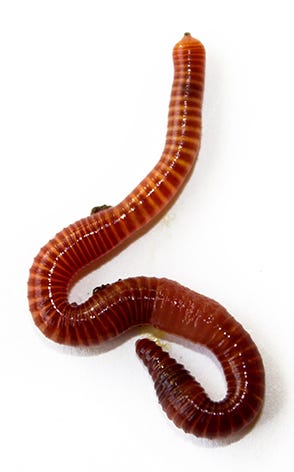Healthy red worms: How to care for
Healthy red worms: How to care for
Blog Article
Transform Your Yard With Red Wigglers: Idea
By establishing a fundamental worm bin and recognizing the nutritional requirements of these remarkable animals, garden enthusiasts can significantly boost dirt high quality and plant wellness. The process of converting organic waste into abundant, abundant spreadings is both simple and satisfying.

Benefits of Red Wigglers
Red wigglers, medically known as Eisenia fetida, are typically hailed as nature's composting champs. These remarkable worms offer numerous key benefits that can substantially enhance garden health and wellness and productivity. Firstly, they are effective decomposers, breaking down organic material such as kitchen area scraps and yard waste into nutrient-rich vermicompost. This natural plant food improves the soil, promoting healthy plant growth and improving dirt framework.

An additional noteworthy benefit of red wigglers is their capacity to minimize waste. By composting organic materials that would certainly or else contribute to landfill waste, they play an essential function in sustainable gardening techniques. Finally, integrating these worms into your horticulture routine can lead to raised returns, healthier plants, and an extra lively yard atmosphere, making them indispensable allies for gardeners looking for to improve their ecological impact.
Establishing a Worm Container
Developing a worm bin is an important action for anybody looking to harness the advantages of red wigglers in their horticulture efforts. A suitable worm container can be made from various materials, consisting of plastic containers, wooden dog crates, or commercially readily available worm containers. The initial factor to consider is size; a bin that goes to the very least 2 feet broad, 3 feet long, and 1 foot deep is usually suitable for a small to medium variety of worms.
It's crucial to create a bed linens layer, using materials such as shredded newspaper, cardboard, or coconut coir to offer a comfy atmosphere for the worms. The bed linens needs to be moist but not soggy, looking like a wet sponge - red worms.
Location the container in an area that keeps a constant temperature level, preferably between 55 ° F and 77 ° F. Avoid direct sunlight or extreme cold, as these problems can damage the worms. When the bin is established, allow the bedding to opt for a few days before presenting the red wigglers, ensuring they have a successful atmosphere in which to grow.
Feeding Your Red Wigglers
As soon as the worm container is developed and the red wigglers are introduced, proper feeding becomes essential to maintaining a healthy and balanced worm populace. Red wigglers prosper on a varied diet regimen, primarily consisting of kitchen scraps and natural products. Suitable foods include veggie peels, fruit scraps, coffee premises, and crushed eggshells. It is important to prevent feeding them meat, dairy, or oily foods, as these can develop undesirable smells and draw in parasites.
When introducing food, cut the scraps into smaller sized items to help with quicker intake. Additionally, hide the food beneath a layer of bed linen product to stop fruit flies and various other nuisances. Display the feeding frequency; a basic regulation is to supply food every 1-2 weeks, depending upon the variety of worms and the quantity of food waste generated.

Harvesting Worm Castings
Just how can you inform when it's time to collect worm spreadings from your container? The readiness of worm castings is indicated by a couple of vital indications. The material in the bin need to appear dark, crunchy, and rich in appearance, resembling a great dirt. In addition, the initial food scraps ought to be considerably broken down or nearly indistinguishable, showing that the worms have efficiently processed them.
Another indicator is the reduction in worm task; as the spreadings accumulate, worms often tend to migrate towards fresher food resources. If you discover a decrease in worm motion and the presence of castings at the end of the bin, it's a clear signal that harvesting schedules.
To harvest, delicately scoop out the spreadings, making sure to minimize disruption to the worms. A popular technique involves dividing the castings utilizing light; worms tend to tunnel far from the light, enabling you to accumulate the castings extra easily.
Collecting frequently, approximately every 3 to six months, makes certain a consistent supply of this nutrient-rich modification for your horticulture ventures. Keep in mind, the quality of your castings straight impacts the health and wellness of your plants.
Making Use Of Castings in Your Garden
(eisenia fetida for sale)Utilizing worm spreadings in your garden can significantly boost soil wellness and plant growth - red worms. These nutrient-rich organic plant foods provide crucial macro and micronutrients, improving the general fertility of your soil. the original source By integrating worm castings into your yard beds, you can promote beneficial microbial task, which helps in vitamins and mineral accessibility and improves dirt structure
To make use of worm castings efficiently, blend them right into the top couple of inches of dirt prior to planting. You can develop a nutrient-dense liquid fertilizer by steeping worm castings in water for a week, then using the resulting "worm tea" directly to your plants.
Worm castings also enhance dampness retention within the dirt, lowering the demand for constant watering. Regularly incorporating worm spreadings right into your horticulture regimen can lead to robust plant growth, increased returns, and a total healthier garden environment.
Conclusion
By developing a worm bin, giving proper food, and routinely gathering nutrient-rich castings, gardeners can foster a lasting community. The usage of worm castings and "worm tea" even more adds to moisture retention and nutrient accessibility in the dirt.
Report this page